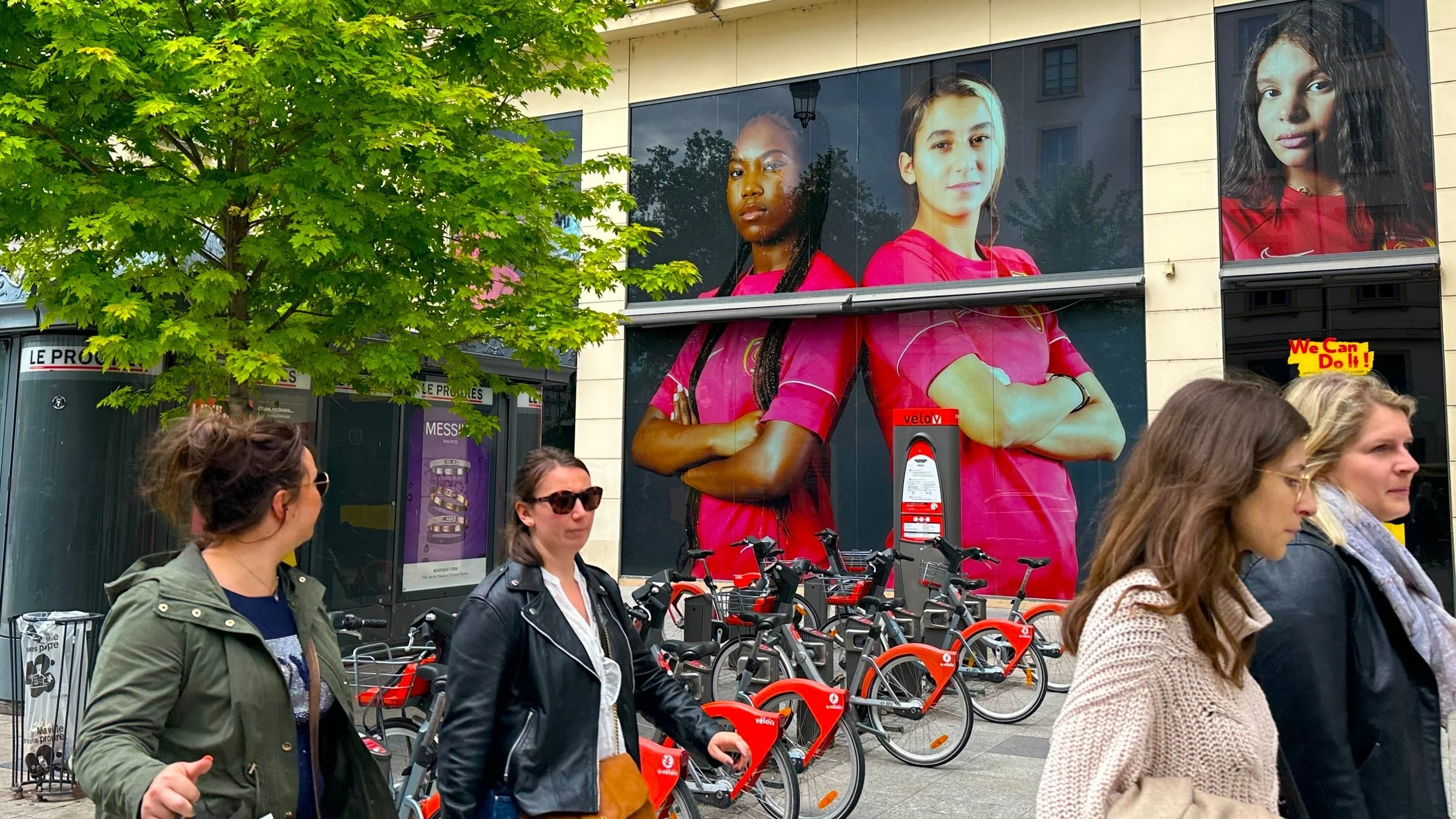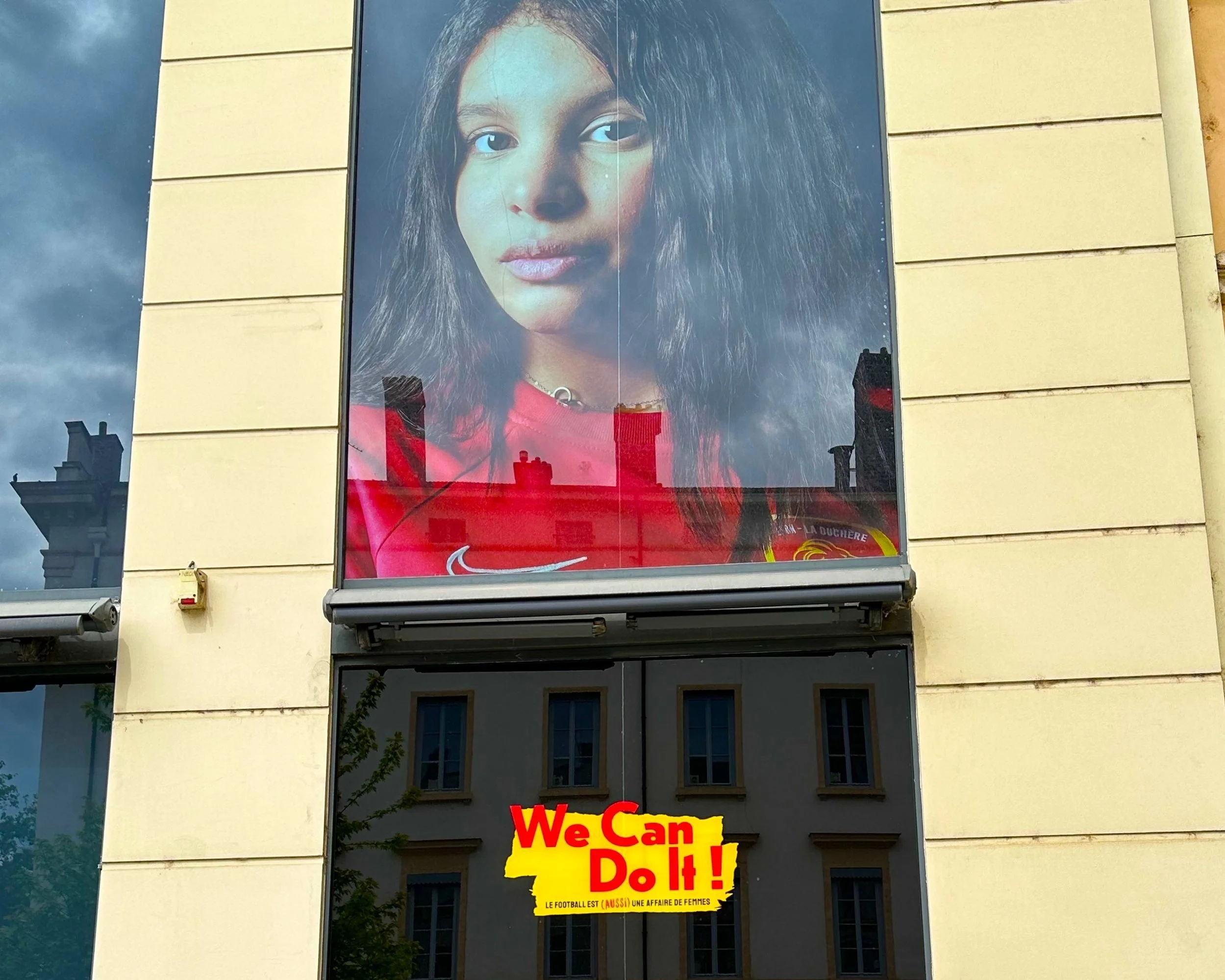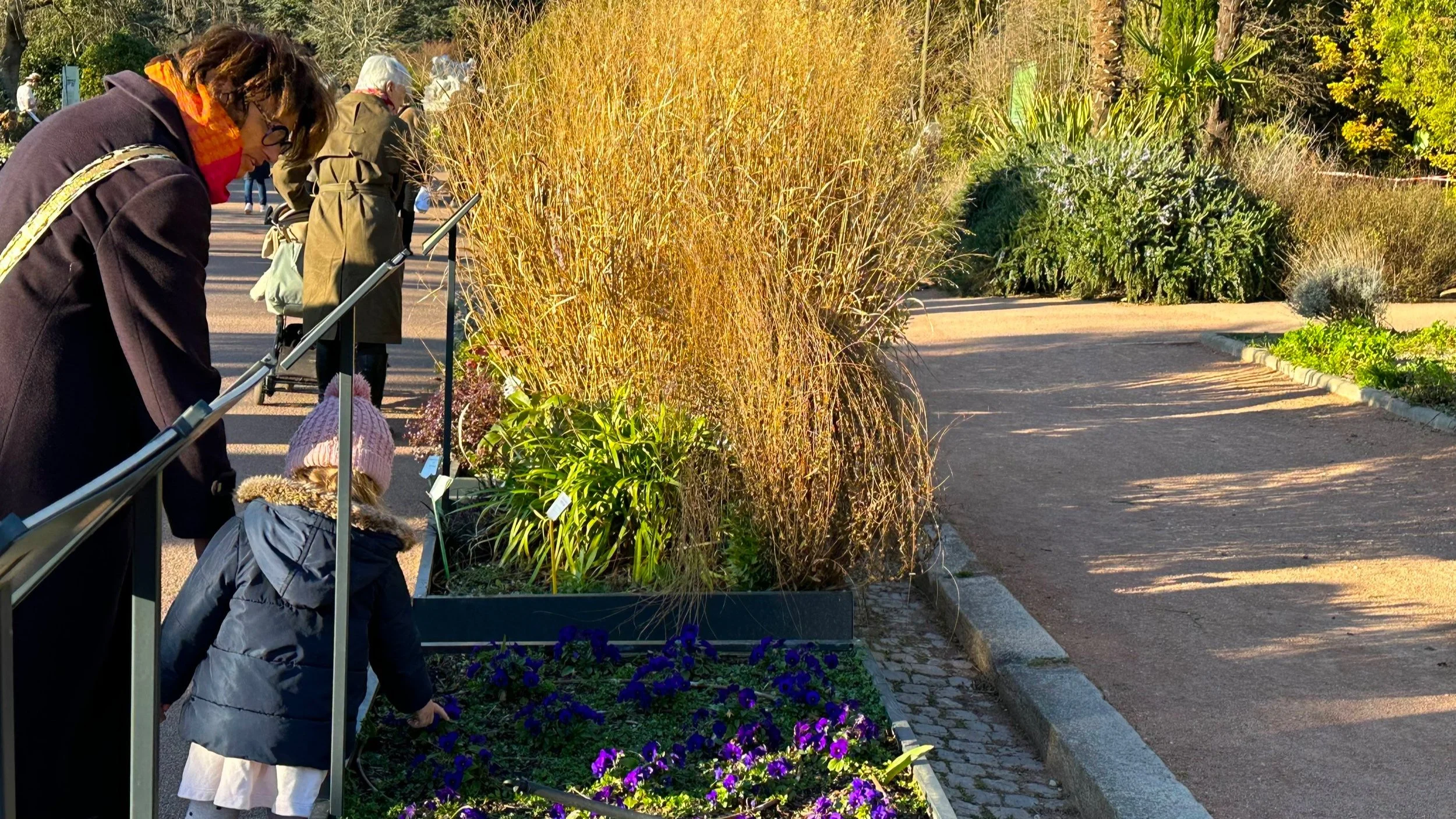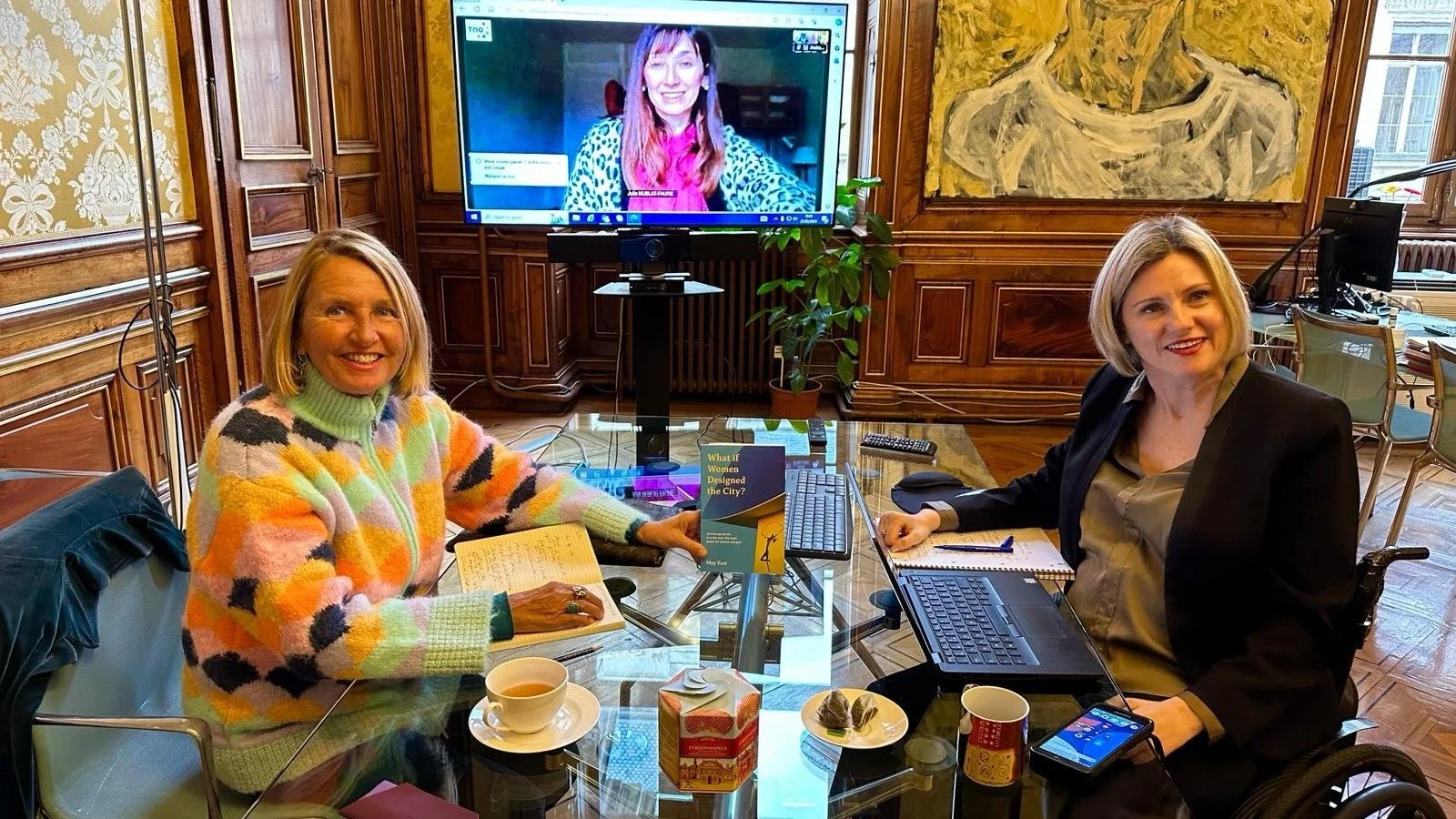Budget allocation ‘pour la feminisation’ of green spaces and competitive sports
Photo exhibition of young female footballers from La Duchère - a compelling urban statement towards the feminisation of competitive sports in Lyon
In cities, male competitive sports tend to dominate how land is allocated in public spaces, compared with what is given over for non-competitive activities. For those who are not active athletes, there are even fewer options in small or medium-sized cities for women and girls. In other words, sports opportunities are not a level playing field. But this is beginning to change.
Ensuring that the right to open green space is more evenly distributed, requires those who hold power within local government to measure the area dedicated to male dominated sports, and formulate policy and planning guidelines to address the gendered imbalances in green space planning and use. There is also need to allocate budget lines to widen the repertoires of activities catering for women and girls’ needs.
This is already changing in Lyon – the largest French city to implement a gender-sensitive budget for sports activities. The city’s approach ensures that initiatives such as women's sports clubs receive equitable subsidies compared to men's clubs, addressing gender imbalances in sports and recreational opportunities.
Lyon’s policies in practice
The establishment of La Duchère club coincided with the construction of new social housing La Duchère in the early 1960s, situated on the western fringes of Lyon's 9th district. Originally, the club served as an association dedicated to supporting the pied-noir residents of French origin who had lived in Algeria during French rule and returned to France following the country's independence in 1962.
Perceived as a ‘place of relegation’, La Duchère district in Lyon has been undergoing transformation for nearly 15 years, thanks to an extensive urban renewal project spearheaded by the Agency of Urban Renewal (ANRU). At the heart of this renewal, lies its football club, which has actively engaged in a process of feminization of its activities, reflecting broader societal shifts and the club's commitment to inclusivity and community development. Being the second club after the famous Olympique Lyonnais, the neighbourhood club is becoming a driving force of women’s soccer in Lyon and consequently needs to procure more land to expand.
The A.S. Monchat football club at the heart of the 3rd district iis another example of feminisation of competitive sports supported by the Ville de Lyon. For 54 years it has dedicated its playing grounds for boys and men. However, in the past two years, the club has undergone a transformative shift by actively engaging with the municipal policies on gender equality in sports. Under the leadership of president Laouali Boueye, the club is effectively spearheading the feminization of its activities.
Key elements for the club's cultural shift were will to change and financial investment. Historically, families of the neighbourhood tended to invest more in sports for boys than forr girls. To address this, the club now offers a 50% fee reduction for girls aged 8 to 18. This strategy has led to a 25% rise in young girls membership with more to come.
As France prepares to host the Olympics, data from ALL IN: Towards Gender Balance in Sport, a joint project by the EU and the Council of Europe, reflects the nation’s journey toward gender equality in sports. Notably, only one Olympic sport federation is headed by a woman. Disparities persist in club and federation memberships, with only 28% of girls and 29% of women involved compared to 71% of boys and 72% of men. French Ministry of Sports has been working with different tools to increase females in decision-making positions in sport such as strategies to increase the number of females in decision- making positions, gender-balanced representation on boards and mentoring programme for (future) females in decision-making positions.
Since 2015, both the French Ministry of Sports and the Olympic Committee have been working to improve the portrayal of women and men practicing sport, through the operation ‘Women's Sport’
©Philippe Galinier Warrain
Former US President Barak Obama asserted that ‘a budget is more than just a series of numbers on a page; it is an embodiment of our values’. The participatory budgeting methodology invented in Porto Alegre and since adopted in many cities around the world, is a manifestation of genuine citizen engagement, prioritising what is needed and meaningful at their local level. Is participation enough? Not according to Donnella Meadows, who suggested that when attempting to understand system malfunctions, it is also essential to pay attention to the rules, and to who has power over them.
To make green spaces equally inviting for and engaged in by women and girls, there is a need to challenge the rules of the system (and those who hold them). We can do this by measuring the amount of land dedicated to competitive sports and addressing the inequities we find; and putting budgets to work to reflect the values of gendered landscapes that widen the space and repertoires of physical activities available for women and girls.
Officials in Lyon view the gendered budget as a transformative instrument addressing societal inequalities guiding decisions in all phases of the budget cycle. Budget allocation and planning guidelines need to occur hand in hand with the redistribution of land. For instance, combining smaller-scale and larger-scale sub-zones in green spaces and better balancing multiple users and uses. Within this mindset, older generations should be allocated protected, shaded spaces with visual access to more lively zones of green spaces, strengthening links to belonging and enhancing their sense of self-worth… while younger generations should be given the opportunity to nurture wonder for the natural world.
The city of Lyon is an exemplar on the relationship between collecting gender-specific data on use of sports equipment followed by concrete actions to strengthen the participation of under-represented users
Measuring land and counting people shows that they count. Lyon is fostering this process by creating policies which are based in data disaggregation captured in their Enquêtes sur l'accès femmes-hommes aux équipements sportifs. Not surprisingly, some findings suggest an overrepresentation of male users in sports facilities, constituting 85% of the total. The city recognises that addressing this design challenge requires both facilitating the redistribution and adapting existing spaces.
Surely, we create the context for what we measure. Redistributing land (space) use and budget allocation for equality and gendered landscapes is one of the 33 leverage points presented in my book What if Women Designed the City? Leverage points are understood as places located in complex urban systems where a small shift in one aspect can produce substantial changes elsewhere. Please be mindful that to apply the concept of leverage points into your city or neighbourhood, finding the right leverage point is only half the journey. The other half concerns activating it in a regenerative direction to cultivate cities that work better for women and girls, as well as for marginalised demographics more broadly.
Read more here.
Analysing the budget of a large city and then applying a gender sensitive approach requires strong political will. Deputy-mayor Audrey HENOCQUE and Julie Faure-Nublat are mastering this timely re-framing.





